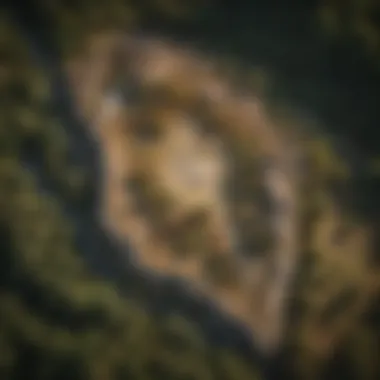Explore Arrowhead Hunting Maps in Arkansas


Intro
Arrowhead hunting in Arkansas is an engaging hobby that appeals to many enthusiasts. The hunt for these artifacts is both an educational and rewarding experience that combines elements of archaeology and geology. Understanding the landscape is crucial for successful arrowhead hunting. This article will explore various aspects of creating and utilizing arrowhead hunting maps specific to Arkansas, highlighting their significance.
The geographical diversity in Arkansas, ranging from hills to river valleys, provides a rich environment for arrowhead collecting. However, it is essential to be aware of the cultural history and the laws regarding collection. Mapping techniques enable hunters to strategically plan their outings and increase the chance of a fruitful discovery.
Rock and Fossil Identification
Identifying rocks and fossils is a key component of arrowhead hunting. Various types of materials often yield artifacts, and understanding local geology can enhance a collector's success.
Types of Rocks and Fossils
Common rocks in Arkansas include chert, flint, and quartzite. These materials are ideal for crafting arrowheads due to their workability and durability. Fossils may appear as part of the substrate, providing additional context to the hunting site:
- Chert: Naturally occurring silica rock, often found in riverbeds.
- Flint: A type of chert known for its sharp edges, ideal for tool making.
- Quartzite: Highly durable and often polished, making it an attractive option.
Characteristics to Look For
When searching for arrowheads, collectors should be vigilant about certain characteristics. Key indicators include:
- Color Variation: Certain hues can help identify distinct types of rock.
- Transparency: Flints often exhibit a translucent quality when held to light.
- Texture: Smoothness can indicate weathering and suitability for flaking.
Tools for Identification
To assist with identification, collectors can employ various tools:
- Hand Lens: A useful tool to examine rock surfaces closely.
- Field Guide: A comprehensive guidebook can provide insights into local geology.
- Digital Apps: Modern tools such as Rock Identifier can help identify rocks and minerals quickly.
Collecting Tips and Techniques
Successful arrowhead hunting goes beyond mere luck. Applying effective strategies and techniques can significantly enhance collecting outcomes.
Best Practices for Collecting
Adhering to best practices can ensure ethical and responsible collection:
- Obtain Permissions: Always seek permission from landowners before hunting on private property.
- Follow Local Laws: Familiarize yourself with state and local regulations regarding artifact collection.
- Leave No Trace: Minimize environmental impact by respecting the natural surroundings.
Locating Prime Collecting Sites
Identifying promising locations is vital. Areas along riverbanks, plowed fields, and ancient trails can be fruitful. Some popular sites in Arkansas include:
- Buffalo River: Known for rich deposits of chert.
- Ouachita Mountains: Offers diverse geological formations.
- Cache River Valley: Provides fertile grounds for discovery.
How to Safely Extract Specimens
Extracting arrowheads requires care to avoid damage:
- Use Hand Tools: A simple trowel or digging stick can facilitate careful excavation.
- Gentle Pressure: Apply gentle pressure when uncovering artifacts to prevent breakage.
- Document Location: Take notes of where artifacts are found to maintain context.
Preservation and Display
Once arrowheads are collected, preserving and displaying them is important to maintain their condition.
Techniques for Preserving Rocks and Fossils
Preservation methods can protect artifacts from decay:
- Clean Gently: Use water and a soft brush to remove dirt without damaging the surface.
- Prevent Moisture: Store artifacts in a climate-controlled environment to prevent mold growth.
Proper Storage Methods
Storage is critical for preservation:
- Use Acid-Free Containers: Keep artifacts safe from chemical reactions.
- Label Clearly: Identify each artifact with pertinent information about the location and date of collection.
Creative Display Ideas


Displaying artifacts can showcase the collector's journey:
- Shadow Boxes: Create visually appealing arrangements that also protect artifacts.
- Glass Cases: Displaying items in glass cases allows for visibility while preventing dust accumulation.
Geological Insights
Understanding the geological context of your finds can deepen the significance of arrowhead hunting.
Geological Formations and Processes
Arkansas has diverse geological features shaped over millions of years, impacting the distribution of arrowhead materials. Key formations include:
- Sedimentary Rocks: Formed from sediment deposits, often rich in fossils and flakes.
- Igneous Intrusions: Provide unique mineral deposits found in certain regions.
Historical Significance of Rocks and Fossils
The artifacts collected often have deep cultural relevance. They give insight into ancient lifestyles, hunting techniques, and the landscape of earlier societies.
Notable Discoveries in the Field
The state has seen outstanding discoveries, from prehistoric artifacts to ancient burial sites, providing a glimpse into the past. These underscores the importance of conducting responsible and informed collection practices.
Preface to Arrowhead Hunting
Arrowhead hunting holds a unique place in the hearts of enthusiasts, especially within Arkansas. The practice is not merely about searching for artifacts; it encompasses a deep appreciation for history and archaeology. Understanding arrowhead hunting encourages collectors to foster a bond with the past, transforming each find into a narrative of human existence.
Importance of the Topic
This article will explore the essential facets of arrowhead hunting and why it matters within the cultural context of Arkansas. The state is rich in archaeological resources, providing an ideal environment for both novice and experienced collectors to uncover remarkable pieces of history. As collectors venture into the field, they gain insights not only into the artifacts themselves but also into the landscapes that shaped their creation.
The pursuit of arrowheads involves more than the thrill of discovery; it requires the understanding of various elements, such as the significance of maps in facilitating successful hunts. By emphasizing the need for precise mapping techniques, this discussion intends to enhance the experience of collectors.
Being aware of the ethical and legal considerations in the field strengthens community engagement. Respect for the land and its history remains a core principle, ensuring future generations can continue to enjoy the practice of arrowhead hunting.
A thorough exploration of the historical context of arrowhead hunting sets the stage for understanding the broader implications of this hobby, turning a simple search for artifacts into an enriching journey through time.
Geographical Relevance of Arkansas
Understanding the geographical relevance of Arkansas is critical in the study of arrowhead hunting. The state's unique topography, climate, and archaeological history contribute significantly to the abundance and diversity of artifacts found by collectors. Being aware of these geographical aspects not only enhances the hunting experience but also improves the chances of successful finds.
The Natural Landscape of Arkansas
Arkansas is characterized by diverse landscapes, ranging from the Ozark Mountains in the north to the low-lying Delta region in the south. This variety is essential for arrowhead hunting as it offers different habitats and geological features that influenced ancient communities. The rivers, such as the Arkansas River and White River, acted as crucial resources for early inhabitants, providing water, food, and material for tool-making.
Particularly, the rich soil and sedimentary layers in these areas often lead to the discovery of artifacts. As you traverse the landscape, consider how the natural surroundings shaped the lives of the people who lived there. For instance, the presence of flint, used widely for making arrowheads, is often found in specific geological formations. Thus, knowing where to look can result in significant discoveries.
Furthermore, seasonal changes greatly impact the visibility of arrowheads. After heavy rains, washes might uncover previously hidden artifacts. Mapping these changes and being observant in different seasons can reveal optimal times to explore various sites.
Notable Archaeological Sites
Arkansas hosts several notable archaeological sites that serve as focal points for collectors. The Toltec Mounds Archaeological State Park is one such location. This site contains large mounds built by the indigenous people, preserving various artifacts, including arrowheads. Another significant location is the Cache River State Park, where the meandering river has exposed numerous sites rich in cultural history.
Additionally, the area around Little Rock is known for its prehistoric artifacts, as it was a significant habitation zone for ancient people. Local efforts to preserve these sites often lead to public outreach programs. This means that participating in community events can enhance your understanding of local history while expanding your network of fellow enthusiasts.
Important places to explore:
- Toltec Mounds Archaeological State Park: Key prehistoric site with mound structures.
- Cache River State Park: Area of rich cultural artifacts resulting from river exposure.
- Little Rock Area: Notable for historical arrowheads and communities of ancient inhabitants.
By being informed about the landscape and historical sites, collectors can navigate more efficiently. Understanding where to hunt and what to expect leads to a more rewarding experience in arrowhead hunting.
The Importance of Maps in Arrowhead Hunting
Mapping plays a crucial role in the field of arrowhead hunting. Understanding your environment can substantially improve success rates when searching for artifacts. Maps serve as essential tools that guide collectors to promising locations. They can reveal historical sites, water sources, and land contours that hint at previous human activity. In Arkansas, where diverse landscapes provide unique opportunities for discovery, the proper use of maps is invaluable.
Maps can also save time and effort. Instead of wandering aimlessly, collectors can plan specific routes based on data gathered from various sources. This organized approach enhances efficiency and increases the likelihood of finding quality arrowheads.
Over time, collectors have found that the accuracy of map information greatly affects their expeditions. Outdated or incorrect maps can lead to fruitless searches, causing frustration. Therefore, having access to up-to-date mapping tools must be part of a collector's strategy.
"The right map can turn an ordinary day of hunting into an extraordinary find."


Knowing what maps to use based on their specific attributes is beneficial. Proper navigation of these resources sets the foundation for a fruitful hunting experience.
Types of Maps Used in the Field
In arrowhead hunting, several types of maps can be utilized effectively. These maps cater to specific needs and can be broadly categorized into:
- Topographic maps: They show elevation changes and land contours, which are crucial for finding ancient sites, since human habitation often clustered near water sources or elevated areas.
- Archaeological maps: These highlight known excavation sites and areas of historical significance, often depicting where important artifacts have previously been found.
- Land survey maps: These provide details on property lines and land usage, especially useful for hunters concerned with trespassing or legal restrictions.
Additionally, digital mapping applications like Google Maps or various GIS software allow for a more interactive approach. Collectors can customize their searches and even overlay multiple data sets—a highly useful feature for comprehensive exploration.
Creating Custom Arrowhead Hunting Maps
Creating personalized maps based on individual experiences and findings adds great value to arrowhead hunting. Custom maps enhance a collector's capability to identify patterns and hotspots over time.
One approach is to begin with a base map from reliable sources, like topographic or archaeological maps. Collectors can then annotate this map with their own field notes about locations where they found arrowheads. By marking important landmarks, such as trees, rocks, or hills, collectors can better remember where they discovered artifacts.
Online resources like GIS software enable this further by allowing the integration of various data layers. Collectors can categorize sites by date of visit, types of arrowheads found, and even the environmental conditions at the time.
In addition, sharing these custom maps with local community groups can enhance collective knowledge, providing insights that may benefit fellow collectors and joint hunting expeditions.
Resources for Finding Arrowhead Hunting Maps
Finding arrowhead hunting maps is crucial for both novice and experienced collectors. These maps guide hunters to likely locations where artifacts can be discovered. Mapping enhances the overall experience of arrowhead hunting by providing direction and context. Proper resources help collectors avoid areas where collection might be illegal or unethical.
Online Mapping Tools and Applications
In today's digital age, several online tools can aid arrowhead hunters. Applications like Google Earth and various surveying sites provide detailed views of the terrain. These resources help uncover potential hunting sites, especially in remote areas.
Some useful online platforms include:
- Google Earth: Offers satellite imagery that allows detailed terrain review. This can help identify landscapes that might naturally encourage artifact deposits.
- ArcGIS Online: Provides access to geographic data layers, which can show historical land usage and archaeological sites.
- Hiking and Outdoor Apps: Apps like AllTrails offer information about trails which could lead to significant areas for hunting.
Using these resources effectively can save time and improve productivity while hunting for arrowheads. Potential collectors can evaluate areas based on not only proximity but also geological features.
Local Resources and Community Networks
Joining local communities and networks can be highly beneficial for arrowhead hunters. Engaging with other collectors often leads to discovering lesser-known hunting grounds. Local sources may include clubs, archaeological societies, and regional forums.
Many hunters share their maps or provide personal insights about successful locations. Platforms such as Reddit and Facebook have groups specifically dedicated to arrowhead collecting. These platforms enable discussions that can lead to new finds.
In addition to community knowledge, local libraries may house maps and other documents pertinent to the history of the area. Visiting such places could yield valuable information not readily accessible online.
Overall, combining both online tools and local resources can enhance the efficiency of arrowhead hunting in Arkansas. Collectors can maximize their potential for discovery through these various channels.
Navigating Legal Considerations
Understanding the legal aspects surrounding arrowhead hunting is crucial for anyone interested in this hobby. Laws governing the collection of artifacts can vary significantly by state, making it essential for collectors in Arkansas to familiarize themselves with the guidelines before embarking on their searching endeavors. Moreover, adhering to these rules not only protects collectors but also preserves the integrity of archaeological sites and promotes responsible practice within the community.
Laws Governing Artifact Collection in Arkansas
In Arkansas, the collection of artifacts is subject to specific regulations. The Arkansas Archeological Survey has established laws to protect cultural resources. Collectors should note that
- Public Lands: It is generally illegal to collect artifacts from state-owned lands without a permit. This includes parks, forests, and other public spaces. Collecting in these areas can lead to fines or other legal repercussions.
- Private Property: Always obtain permission from landowners before searching on private property. The absence of permission could lead to trespassing charges.
- Underwater Sites: Arkansas law recognizes the significance of submerged cultural resources. Special regulations exist for collecting artifacts from lakes, rivers, and surrounding areas.
Being aware of these laws ensures that collectors can enjoy their hobby without falling victim to unintended legal issues. Clear understanding and adherence to these regulations foster a responsible and respectful community.
Ethical Guidelines for Collectors
Alongside legal considerations, ethical collecting practices play a crucial role in preserving Arkansas's cultural heritage. The following guidelines can help collectors maintain high standards while pursuing their interest in artifacts:
- Respect Cultural Heritage: Only collect artifacts that can be freely obtained without damaging historical sites or disturbing the archaeological record. This includes practicing leave no trace principles.
- Document Your Finds: Keeping a detailed record of where and what has been collected provides valuable information for future generations of researchers and hobbyists alike. This documentation may include photographic evidence and exact GPS coordinates.
- Share Knowledge: Engage with local collector groups and forums. Sharing information benefits the entire community and contributes to the collective understanding of Arkansas’s archaeological history.
- Educate Yourself: Stay informed about local history, archeology laws, and finding techniques. This knowledge enhances both personal collecting practices and the broader discussions within the collector community.
Collecting arrowheads is not just a personal hobby; it is a responsibility that connects us to the past and influences future generations.
Best Practices for Responsible Collecting
Responsible artifact collecting is crucial for preserving the rich historical context of arrowhead hunting in Arkansas. Many collectors prioritize the thrill of discovery, but with this excitement comes a responsibility toward the land and its cultural heritage. This section discusses essential practices that collectors must adopt to ensure their activities do not harm the environment or violate any legal standards.
Covering Ground: Finding Locations


Identifying the right locations for arrowhead hunting is an art within itself. Experienced collectors emphasize that proper research is key to successful hunting. Understanding the historical contexts and archaeological significance of various areas can greatly enhance your search.
Finding locations involves both technology and traditional methods. Online mapping tools can provide insight into regions with historical artifact finds. Resources like Google Earth or specialized archaeological databases can highlight potential hunting spots.
In conjunction with digital research, one should explore local parks, river banks, and old settlements. These areas often yield promising finds. Keeping in mind seasonal changes is vital, as water levels and vegetation can affect accessibility. Furthermore, taking time to engage with local collectors or forums can reveal rarely spoken about locations.
- Good places to start:
- Riverbeds and floodplains
- Old homestead sites
- Areas near historical battlefields
This multi-faceted approach not only optimizes your chances of finding artifacts but also ensures that you are hunting responsibly within designated legal boundaries.
Properly Documenting Finds
Proper documentation is critical for any collector. Not only does it create a detailed record of your finds for personal purposes, but it also contributes to the broader understanding of the area's archaeological significance. Documentation should include the location, date, and surrounding conditions at the time of the hunt.
Investing in a good notebook or using mobile applications dedicated to recording finds can assist you. Each entry should contain detailed sketches or photographs, along with notes describing the context in which the artifact was found. Consistent documentation not only helps in future hunts but also aids local institutions and researchers.
- When documenting,
- Include GPS coordinates or map references.
- Note type of soil, vegetation, and nearby landmarks.
- Keep a photographic record of the artifact in situ.
This thorough approach ultimately contributes to responsible collecting by ensuring that the provenance of each artifact is respected and recognized.
"Responsible collecting respects both the land and the history it holds."
Engaging in best practices while hunting ensures that future generations can also explore the rich past of Arkansas without the risk of depleting its resources.
Community and Knowledge Sharing
Community and knowledge sharing are crucial aspects of arrowhead hunting in Arkansas. The practice not only fosters relationships among collectors but also enhances the overall experience and understanding of the hobby. Connect with others to exchange information, resources, and techniques that will refine your skills and boost your success in finding arrowheads. Collectors often have unique insights based on their individual experiences, and sharing these can significantly contribute to the community's collective knowledge.
Collaboration can lead to discoveries about locations, types of artifacts, and tips for responsible hunting. Collectors who engage regularly often find that they have access to better resources, maps, and local knowledge. Networking with more experienced collectors can provide mentorship opportunities, which is invaluable for novices looking to deepen their understanding of hunting practices.
Benefits of community engagement include:
- Access to exclusive locations: Experienced collectors know spots that are often overlooked, providing an edge in your search.
- Learning opportunities: Workshops and meet-ups are common, enabling peer learning and skill enhancement.
- Sharing legal insights: Knowledge about local laws and regulations can be shared among members, ensuring everyone is informed and compliant.
It is the connections within the community that often lead to some of the most profound insights into arrowhead hunting, enriching the practice for everyone involved.
Engaging with Local Collectors
Engaging with local collectors opens doors to a wealth of knowledge and experience. Local clubs and meet-ups can be pivotal in establishing a strong network among collectors in Arkansas. Joining these groups allows for real-time discussions and exchanges about techniques and discoveries.
When engaging with local collectors, consider the following approaches:
- Attend local meetings: These gatherings provide a platform for sharing experiences and insights.
- Participate in field trips: Many collectors organize group hunts, allowing novices to learn from more seasoned hunters.
- Support local events: Many areas host shows or exhibitions where collectors can showcase finds and share stories.
Building rapport within this community creates lifelong relationships. Dedicate time to listen and learn from others, and you may discover vital information that will enhance your collecting journey.
Participating in Forums and Online Groups
In addition to in-person interactions, online forums and groups serve as valuable avenues for knowledge sharing. Platforms like Reddit and Facebook host vibrant communities where collectors can exchange information in a more dynamic setting. These forums allow for discussions that can include anything from the best hunting strategies to sharing maps of newly discovered sites.
Consider engaging actively in these online spaces by:
- Asking questions: Whether you are a novice or an experienced collector, there is always something new to learn.
- Sharing your own finds: Presenting your discoveries encourages others to share theirs, fostering a culture of exchange.
- Offering advice and tips: As you learn, share what you know with others, reinforcing your own knowledge while aiding your peers.
The wealth of perspectives found online can be just as beneficial as those in person. The more you involve yourself, the more you will cultivate a rich understanding of arrowhead hunting practices while helping others in the process.
End
In wrapping up the discussion on arrowhead hunting in Arkansas, it's clear that a thorough understanding of mapping techniques is fundamental for both novice and seasoned collectors. The significance of accurate maps cannot be overstated as they provide not just location guidance, but also context regarding the history and distribution of artifacts. Using the right tools and resources enhances the overall experience, allowing for more informed decisions while hunting.
Summarizing Key Points
Throughout our exploration, we covered several important elements:
- The natural landscape of Arkansas shapes where and how collectors search for arrowheads.
- Utilizing a variety of maps, including topographic and geological types, can significantly improve one’s chances of success.
- Online platforms and community networks are invaluable for sharing local knowledge and experiences.
- Understanding legal considerations and ethical practices is essential in protecting archaeological integrity while pursuing personal interests.
- Responsible collecting not only preserves the environment but also respects the cultural heritage of the area.
Future Directions in Arrowhead Hunting
The world of arrowhead hunting continues to evolve. With advancements in technology, such as mobile mapping applications and geolocation tools, collectors can be more precise in their searches. Additionally, ongoing research into local archaeology may unveil new hunting grounds.
In the future, we can expect a greater emphasis on collaborations within the collector community, sharing data about finds and locations in ethical ways. Furthermore, as environmental awareness grows, sustainable practices in artifact hunting may be prioritized, leading to improved regulations and educational opportunities. This indicates a promising evolution in the field, underscoring the importance of community engagement and responsible practices.







